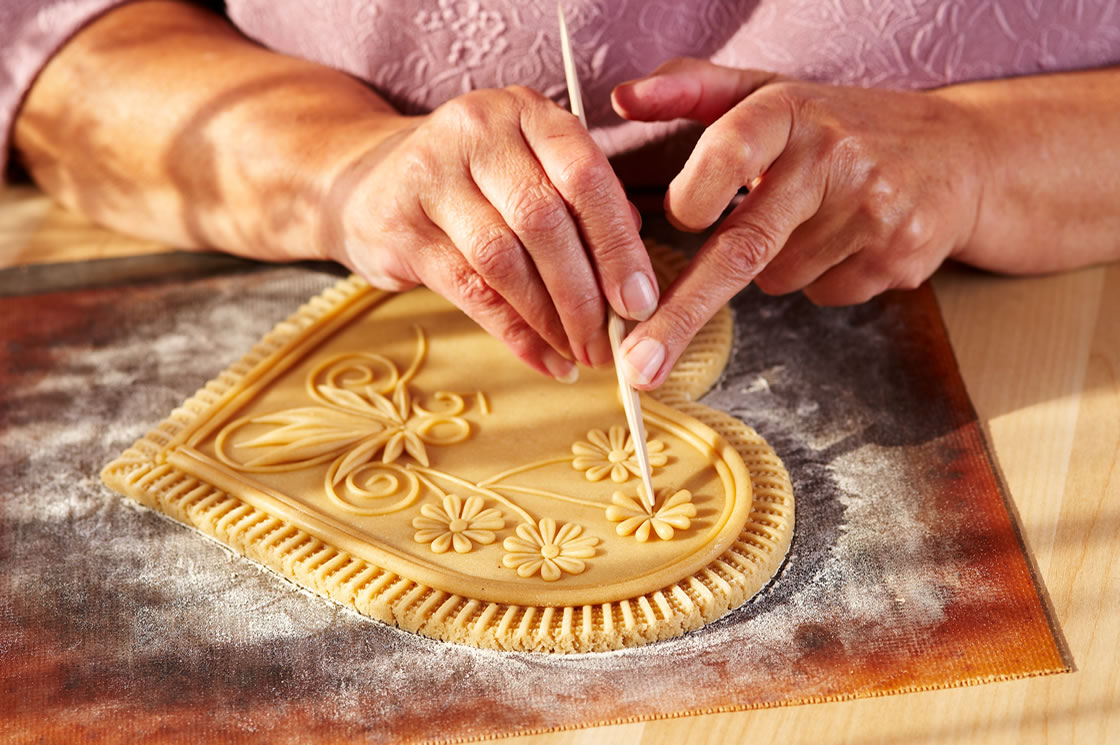Julian Alps | Bohinj
Alpine Flower Festival Bohinj
-
Julian Alps

Darinka Megušar makes Dražgoše gingerbread, ®elezniki | © www.slovenia.info Photographer: Tomo Jesenicnik
 Slovenian Tourist Office
Slovenian Tourist OfficeThe golden autumn season primarily attracts gourmets, wellness fans and wine lovers to Slovenia. No wonder, because now is harvest time,
and the diverse delicacies come especially fresh to the table. From A like "Ajdovi Krapi" (pasta made from buckwheat) to Z like "Telševka", a potato dish with chives, Slovenia's dishes present themselves to its vacationers and visitors as diverse as the country itself.
Due to its location at the crossroads of Central and Eastern Europe, Italians, Austrians, Hungarians and Slavs have all left their mark on the local cuisine over the centuries. The diverse culinary specialties can be tasted in inns, so-called Buschenschänken and tourist farms. An absolute must is the famous Kraški Pršut, a ham dried for months in the wind of the Karst, which also serves as a delicious prelude to a typical Slovenian meal. The second course is often a soup, where diners are spoilt for choice between clear meat broths, creamy mushroom creams or hearty stews such as the popular pasulj made from smoked meat, sauerkraut and beans.
Meat specialties include fatty, well-seasoned sausages from Upper Carniola, rice sausages from Lower Styria and numerous game dishes. Fish lovers get their money's worth with the delicious brown trout from the Soca River, while crustaceans and mussels dominate on the coast. With a variety of Štruklji, Slovenians bring strudel to the table in every conceivable variation: as an appetizer, for example, with meat, cracklings and tarragon, or for dessert as a sweet curd, poppy seed, nut or apple strudel. As the crowning glory of a meal, one enjoys potica, a kind of yeast strudel into which various fillings such as nuts, raisins, cottage cheese, poppy seeds and honey are rolled.
Good to know:
Kraški Pršut - Prosciutto - Karst ham matured for at least 16 months.
For centuries, at the beginning of December, the best pork hams in the Karst region have been selected and salted with coarse sea salt from the Piran salt pans. The hams are then salted for three months and left to rest in the cool of the Karst winter. In spring the salted hams are hung up in the attic, where the pleasant Karst wind dries them slowly. Dry, cold wind from the mountains gives the ham its characteristic aroma and taste. At least 12 months is required until this ham is ripe. Due to the dry climate the Karst Prosciutto has got its attractive rosy-red color, its noble taste and its firm consistency.
When the snowflakes dance and wrap nature in brilliant white
To the heights the heart wants ...
Welcome to green Slovenia
Juliana Bike Cycle Route
Adrenaline and new experiences
Slovenia Unique Experiences